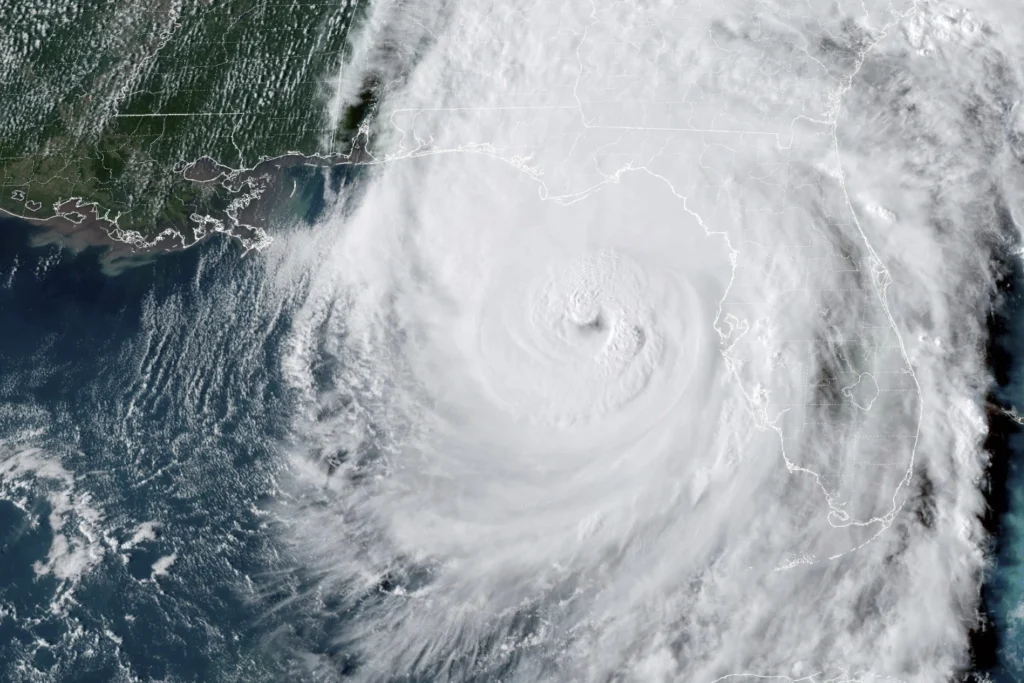CRAWFORDVILLE, Florida (AP) — Hurricane Helene made landfall Thursday night in northwestern Florida as a Category 4 storm as forecasters warned that the enormous system could create a “nightmare” storm surge and bring dangerous winds and rain across much of the southeastern U.S.
The National Hurricane Center in Miami said Helene roared ashore around 11:10 p.m. EDT near the mouth of the Aucilla River in the Big Bend area of Florida’s Gulf Coast. It had maximum sustained winds estimated at 140 mph ( 225 kph). That location was only about 20 miles northwest of where Hurricane Idalia came ashore last year at nearly the same ferocity and caused widespread damage.
Helene prompted hurricane and flash flood warnings extending far beyond the coast up into northern Georgia and western North Carolina. More than a million homes and businesses were without power in Florida and more than 50,000 in Georgia, according to the tracking site poweroutage.us. The governors of Florida, Georgia, Alabama, the Carolinas and Virginia all declared emergencies in their states.
One person was killed in Florida when a sign fell on their car and two people were reported killed in a possible tornado in south Georgia as the storm approached.
“When Floridians wake up tomorrow morning, we’re going to be waking up to a state where very likely there’s been additional loss of life and certainly there’s going to be loss of property,” Florida Gov. Ron DeSantis said at a news conference Thursday night.
The National Weather Service in Tallahassee had issued an “extreme wind warning” for the Big Bend as the eyewall approached: “Treat this warning like a tornado warning,” it said in a post on X. “Take shelter in the most interior room and hunker down!”
Even before landfall the storm’s wrath was felt widely, with sustained tropical storm-force winds and hurricane-force gusts along Florida’s west coast. Water lapped over a road in Siesta Key near Sarasota and covered some intersections in St. Pete Beach. Lumber and other debris from a fire in Cedar Key a week ago crashed ashore in the rising water.
Beyond Florida, up to 10 inches (25 centimeters) of rain had fallen in the North Carolina mountains, with up to 14 inches (36 centimeters) more possible before the deluge ends, setting the stage for flooding that forecasters warned could be worse than anything seen in the past century.
Heavy rains began falling and winds were picking up earlier Thursday in Valdosta, Georgia, near the Florida state line. The weather service said more than a dozen Georgia counties could see hurricane-force winds exceeding 110 mph (177 kph).
In south Georgia, two people were killed when a possible tornado struck a mobile home on Thursday night, Wheeler County Sheriff Randy Rigdon told WMAZ-TV. The damage was reported as heavy thunderstorms raked much of the state. Wheeler County is about 70 miles (113 kilometers) southeast of Macon.
Forecaster Dylan Lusk said the National Weather Service issued a tornado warning for Wheeler County at 8:47 p.m. on Thursday. He said it’s one of 12 tornado warnings the office near Atlanta issued for parts of Georgia between 1 p.m. and 11 p.m.
The storm made landfall in the sparsely-populated Big Bend area, home to fishing villages and vacation hideaways where Florida’s Panhandle and peninsula meet.
“Please write your name, birthday, and important information on your arm or leg in a PERMANENT MARKER so that you can be identified and family notified,” the sheriff’s office in mostly rural Taylor County warned those who chose not to evacuate in a Facebook post, the dire advice similar to what other officials have dolled out during past hurricanes.
Still, Philip Tooke, a commercial fisherman who took over the business his father founded near the region’s Apalachee Bay, planned to ride out this storm like he did during Hurricane Michael and the others – on his boat. “If I lose that, I don’t have anything,” Tooke said. Michael, a Category 5 storm, all but destroyed one town, fractured thousands of homes and businesses and caused some $25 billion in damage when it struck the Florida Panhandle in 2018.
Many, though, were heeding the mandatory evacuation orders that stretched from the Panhandle south along the Gulf Coast in low-lying areas around Tallahassee, Gainesville, Cedar Key, Lake City, Tampa and Sarasota.
Among them was Sharonda Davis, one of several gathered at a Tallahassee shelter worried their mobile homes wouldn’t withstand the winds. She said the hurricane’s size is “scarier than anything because it’s the aftermath that we’re going to have to face.”
Federal authorities were staging search-and-rescue teams as the weather service forecast storm surges of up to 20 feet (6 meters) and warned they could be particularly “catastrophic and unsurvivable” in Apalachee Bay.
“Please, please, please take any evacuation orders seriously!” the office said, describing the surge scenario as “a nightmare.”
Preparing for a hurricane
Jaime Hernandez, the emergency management director for Hollywood, on Florida’s Atlantic Coast, says his team encourages people to do three key things: make a plan, have an emergency kit and stay informed.
Preparing for a hurricane also includes getting supplies in advance, including nonperishable foods and water in case power is lost and supplies are low in the community. Preparedness also includes ensuring all medical items and medications are ready in case people are unable to leave their homes.
Emergency kit necessities
The rule of thumb is to have 1 gallon (3.8 liters) of water per day per person for about seven days, Hernandez says. It’s also a good idea to have cash on hand since ATMs may not be working.
Evacuating ahead of a storm
Officials advise residents listen to their local emergency management officials, who will have the most updated information about evacuation zones.
By HEATHER HOLLINGSWORTH and KATE PAYNE/Associated Press

